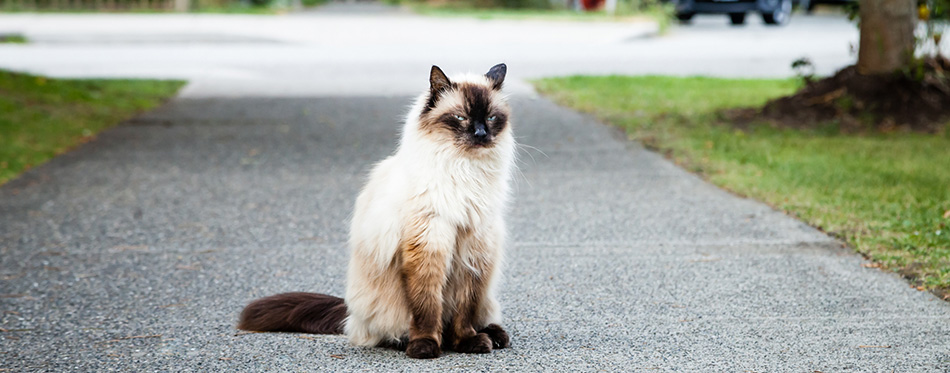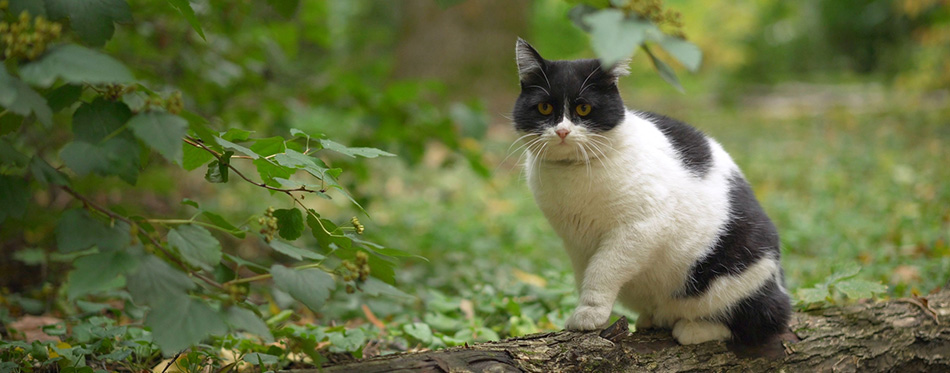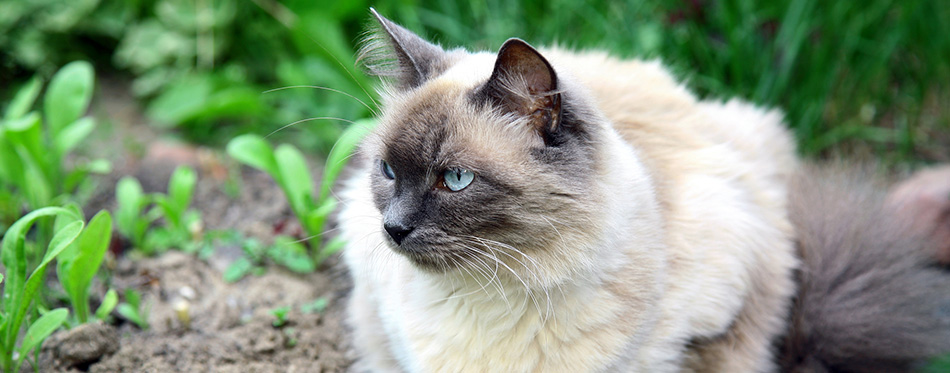I have some questions for you. Have you ever been to Indonesia? Have you ever visited the exotic island of Bali? Have you ever seen the beautiful and graceful Balinese dancers glide nimbly and move effortlessly to the rhythm of the exotic drums? If you have, you will be able to recognize some things in common with the main subject of this blog article. If you have not, then get ready to be introduced to (drum roll) the Balinese cat. And no, the Balinese cat is not a dancer. What it is though, is an exotic-looking cat breed named after the exotic and graceful dancers on the Indonesian island of Bali. This exciting breed of feline is all you need if you are looking for an exciting companion in a cat, or a cat that will get along just fine with your kids. With the Balinese cat, there is never a dull moment – well, unless it is nap time. Some owners have nicknamed this cat as a non-stop chatter. This is because, this cat loves to make conversations for as long as you let it, despite the fact that it appears rather aristocratic. It is nimble on its paws, agile, and has the ability to leap to impressive heights with very little effort. So if you are ready for some fun-filled information about the Balinese cat before deciding whether or not it is the cat for you and your family, then strap in, buckle up, and let us learn about this special cat.

History
Before going on, it is best to go back in time and find out where the Balinese cat breed comes from. And it is important to start with a spoiler – the Balinese cat is not from Bali, neither is it from any part of beautiful Indonesia. It is from another beautiful country – the United States Of America. Yup, you heard right. And if you are wondering why it is called a Balinese cat, well, their history can be traced to Thailand. In the mid-80s, the first Siamese cats entered the United States Of America from Thailand. Some of these cats had the recessive genes that gave them very long fur which most breeders considered faults since no other breed was included in the Siamese breeding program. And despite the fact that nothing was wrong with the breeding program, some kittens still had very long fur. It was not until the mid-1950s that there was a conscious attempt to develop these long-hair cats a different breed on their own. Among the breeders was Sylvia Holland. In the 1960s and 1970s, she focused on breeding the long-haired cats with each other. She nicknamed the breed Balinese in reference to the Balinese dancers and the grace they carried. The name was preferred since it was becoming too difficult to find a different name for them. With time, the Balinese breed produced two separate varieties based on their physical traits. There was the apple-head type which was the preferred choice at then. This breed had comparatively shorter hair. Then there was another variety that had wedge-shaped heads. This type had longer hair and a slender body. Over the years, the distinction between both types of Balinese breed has disappeared significantly.
Quick Facts About The Balinese Cat
It is time for some quick facts about the Balinese cat.
- Prepare for snuggling: The Balinese cat loves to snuggle. If it has nothing else to do, it does not mind leaping unto your lap when you are watching your favorite movie, or snuggling under your sheets with you when it is time for bed. All you have to do is give it an extra pillow.
- A chatty buddy: As mentioned earlier, some owners have described their Balinese cats as chatty Cathys. This cat breed does not mind sharing a conversation with you for as long as it can. And the fact that it has a very gentle and soft voice makes its constant chattering tolerable if not adorable. It does not really care if you do not understand a word; it just loves to ‘talk.’ However, it does have some quiet moments. But those moments are when it is asleep. So the question you should ask yourself is, do you have a listening ear?
- Alone time: You may be guessing by now that the Balinese cat cannot be by itself without getting bored. Well, that is not entirely accurate. This cat has the ability to entertain itself in your absence. But it will need some help. It appreciates the fact that its owner needs to go out to work and bring food home. All it requires from you is not to leave it idle. It must be left with enough entertainment to keep it busy and active until you return – cat videos and toys will do just fine. But if you have a spot in front of the window perch where it can watch birds, that is a plus.
- Long-haired cousins: If you are wondering if the Balinese cat looks familiar, it is because it does. This cat breed has a long-haired version. As mentioned earlier about the origin of this cat breed, the long-haired Balinese cat’s appearance still baffles cat breeders. Considering, the fact that no crossing was done with any other cat breed during the breeding program, it is a bit strange how the long-haired cousins appeared.
- Busy-body: This cat breed is agile, active, and very playful. To repeat, there is never a dull moment. It loves to be challenged with puzzle-solving games because it is a very intelligent cat. If you get to own one, you find it constantly on the move.
- A family-cat: This should not come as a surprise by now. The Balinese cat loves attention and human company. There is only one condition, though, whoever is around must be ready to listen to some long talk. This cat breed is comfortable with any family size as long as it is given all the attention it demands. It is also warm with other animals in the home.
- Mood-reader: One thing most owners love about the Balinese cat is its ability to read the moods of its owner. Believe it or not, this cat can sense the emotions of its owner. It does not end there; it is naturally gifted in the art of cheering people up. So if you are feeling down, just get a Balinese cat.
- Strong personality: You may have guessed correctly by now that the Balinese cat has a big personality. It is not a shy breed of cat. It is bold, friendly, sociable, intelligent, and even has its own opinions. And, needless to add, this cat will make sure you hear all of its opinions even if you do not understand anything it says.
- Weight and appearance: The Balinese cat weighs from six to eight pounds for the males and five to seven pounds for the females. This makes them medium-size cats. The slender bodies with visible bone structures that make their bodies appear long and muscular. The furs on their coat hardly tangle, and this makes for easy brushing. The fur can be as long as a couple of inches. Also, Balinese cats have no undercoats.
- Life expectancy: A Balinese cat is expected to live for an average of fifteen to twenty-five years.
- One last quick fact, as a quick reminder – the Balinese cat does not dance.

Things You Should Know
Health
Whenever a feline population is a descendant of a small number of ancestors, there are health issues. As compared to Siamese cats in the past, Balinese cats of today are considered healthier and sturdier than they used to be. This, however, does not exempt them from certain health issues.
Eye problems are common in this breed of cat. Balinese cats are usually prone to retinal degenerative diseases which could lead to blindness. They are also prone to certain neuroanatomical conditions that could lead to crossed eyes. Crossed eyes may lead to visual impairment. Balinese cats could also suffer from liver amyloidosis. This condition causes the liver’s function to reduce. It can also lead to a failure of the heart. Another health issue the Balinese cat could struggle with is hypertrophic cardiomyopathy. It has been observed that this condition is most common in Balinese cats. Hypertrophic cardiomyopathy causes the muscle tissue to become thick, especially in the heart’s left ventricle. This affects the heart’s ability to pump blood and could lead eventually to heart failure. Balinese cats, as well as Siamese, in general, are vulnerable to diseases that affect the central nervous system. This may cause abnormalities like seizures and abnormal changes in the behavior of the cat. This is caused by a lack of myelin which insulates the nerve cells. Balinese cats may also suffer from chronic bronchial diseases. Especially prone are the kittens. However, respiratory infections are very common in cat breeds that are related to the Siamese cat breed.
Feeding
Just like every carnivore, a Balinese cat requires a diet rich in protein. Experts suggest that you should always purchase the best cat food you can find. You can consult your veterinarian for recommended brands to buy. Based on the age of your Balinese cat, it is advisable to establish a feeding-routine. A kitten below thirty weeks old can be fed three meals in a day, mostly milk. A kitten that is over thirty weeks old, but below twelve months can be given two meals each day. An adult Balinese cat may be fed once or twice a day. Although ninety percent of the Balinese’s diet should be protein, it is okay to treat it once a while with some fruits as snacks. But always pay attention to its reaction first. Also, only feed it tiny amounts at a time. Please do not feed it garlic, onions, or chocolates. It is also advisable not to give your cat too much carbohydrate. Keep your Balinese cat hydrated by providing it with fresh water every day. But avoid feeding milk to an adult Balinese cat. The feeding-bowl must be always be washed clean after each feeding. The water bowl must also be kept clean, and the water changed often.
Head over to our reviews of Kitten Food, Dry Cat Food and Wet Cat food for more info.
Care
The Balinese cat has a silky coat which is not only good to look at but also very easy to brush since the hair hardly tangles. The hair should be combed at least once every week. It is best to use a stainless steel comb when trying to remove dead hair. Cats hate water, so you will find your Balinese cat very disagreeable when you try to give it a bath. However, cats do a very good job of grooming themselves, so regular bathing is not necessary. What is necessary is to brush your cat’s teeth regularly. Doing this will help prevent periodontal disease. It is recommended that you brush your cat’s teeth daily. However, doing it two times a week is acceptable. Using a soft and damp cloth, carefully wipe the corners of the cat’s eyes to remove any discharge. Be careful to use a different cloth for each eye. Using a soft and damp cloth or cotton ball, clean the ears of the cat once a week. The cloth should be moistened with a mixture of warm water and vinegar. Cats love their litter boxes clean and dry always. To keep your Balinese cat safe from diseases from other animals, it is wiser to keep your cat indoors. This will also keep it safe from vehicular accidents or cat-thieves.
Check out our guides on Cat Toothbrushes and Cat Toothpaste for more info.
Grooming
The main difference between the Balinese cat and their Siamese cousins is the length of their hair. The hair is capable of growing as long as one or two inches. This gives the cat a fine coat of silk. But while most long-haired cats have an outer coat as well as an undercoat, the Balinese cat has only a single coat of hair. The long hair lies down and flows towards the tail of the cat. The hair on the cat’s tail can grow as long as five inches. This gives it a plumed and beautiful look. Because the Balinese cat has only a single coat of hair, it does not require frequent brushing. The only thing it needs it to be combed quickly once a while to help remove dead hair. As mentioned earlier, it is best to use a stainless steel comb. When combing, it is advisable to comb in the direction of the hair. When trying to remove particles or insects trapped in the hair, it is advisable to comb in a downward direction. This will make sure that the particles fall down from the hair and are not transferred to other parts of the cat’s body. Take a look at our review of the best cat brushes for more options.

Temperament
To say that the Balinese cat is fond of humans could be an understatement. It loves to follow its human around like a bodyguard supervising their every move while chattering away non-stop. And the moment a Balinese cat notices that you are seated comfortably, it will leap unto your lap without permission for some petting. At night, it will follow you straight to bed, share your bed, and even place its head on the pillow just like humans do. On the bed, its favorite position is close to the feet of the human. Thus, this is not ideal for people who kick in their sleep or move a lot when they sleep. Just like its Siamese cousins, the Balinese cat is a talker and very opinionated. As if that is not enough, it will demand that you pay attention to everything it has to say. Most owners will admit that their cats do not hesitate to “tell-all” to visitors that show up. So it is a huge relief that people do not understand the feline language. Else, your secrets are never safe around them. The Balinese cat is a very intelligent cat. Its intelligence level is well above average. Thus it enjoys problem-solving games like puzzles. It also enjoys any game that stimulates its mind. As much as it loves human company, it does not mind being left by itself as long as you keep it busy with cat toys to play with. A few games of throw and fetch in the backyard will be much appreciated also. The Balinese cat is a bold and sociable animal. It does not mind having other animals around. On the contrary, it loves the fact that there are others to play with and ‘talk’ to. So, as a note of caution, do not go for a Balinese cat if having an opinionated, talkative busybody will drive you nuts. Because that is exactly what you will get from the Balinese cat.
To Summarize
So, there you have it. Whether or not a Balinese cat is a good choice for you depends on, well, you. These cats are not only beautiful, but they are also very intelligent and make for a really good companionship with humans. If you are convinced, after reading this blog article, that you have found your feline buddy, what are you waiting for?
Sources:
- About the Balinese – CFA
- Balinese – International Cat Care

